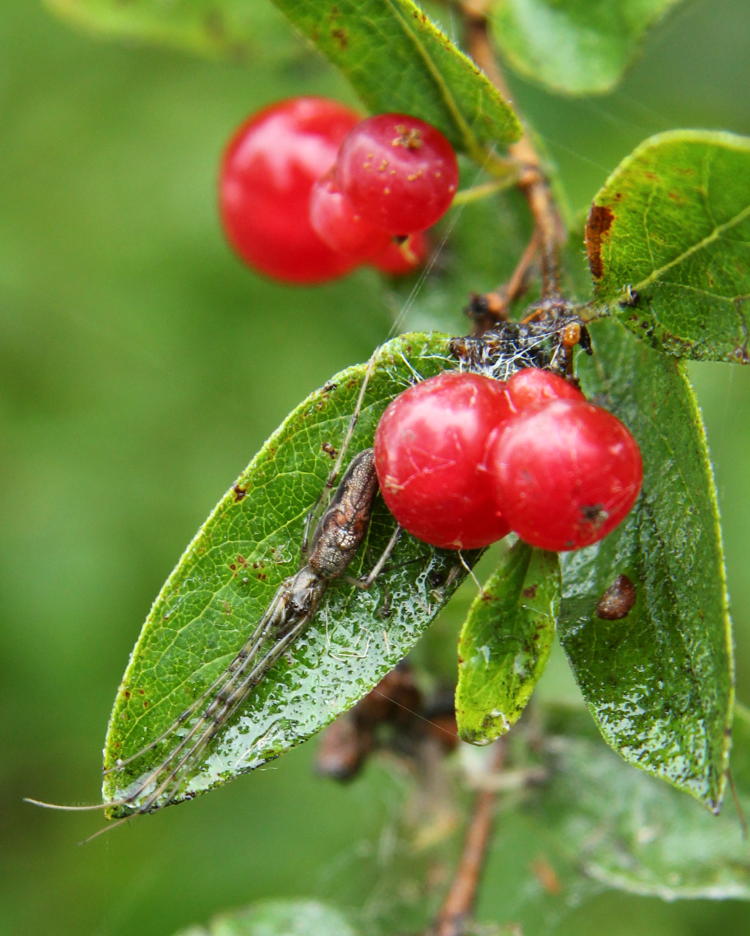I have a serious number of images from my trip up to the area where I grew up, which is the Finger Lakes region of central New York, but haven’t had a lot of time to write anything up about them, so I decided to split the posts into two and make them relatively brief. For me, anyway – this might mean upwards of five-thousand words or so, but you should already know that this is what the site is like, and the “TL;DR” crowd have long since scampered away up their own ignorant asses, so…
This post, as the title says, is going to be dedicated to the animals that I encountered – nothing too exciting, and certainly nothing exotic, but I also only spent a handful of days there in the first place. One of the reasons that I was up there (among several others) was that my brother had been sighting bald eagles quite close at an estate where he worked, the aforementioned ‘Gatsby Mansion’ in the holiday post. The owners were extremely kind in allowing me to stay there, so I was able to check out the conditions at all hours of the day, and since it sat right on Cayuga Lake (only about ten kilometers south of where I used to live,) there remained a variety of things to see. Unfortunately, only one eagle made a brief appearance early one morning, keeping just below the treeline and thus obscuring any decent view, and the other birds in the area were being almost as shy. While I watched several osprey (Pandion haliaetus) well over a hundred meters off, I was never able to get anything too close, and thus nothing too impressive – this is despite the fact that there was a sizable osprey nest on one of the chimneys of the very house that I stayed in, but we were well past nesting season and I was told it was probably last year’s nest anyway.
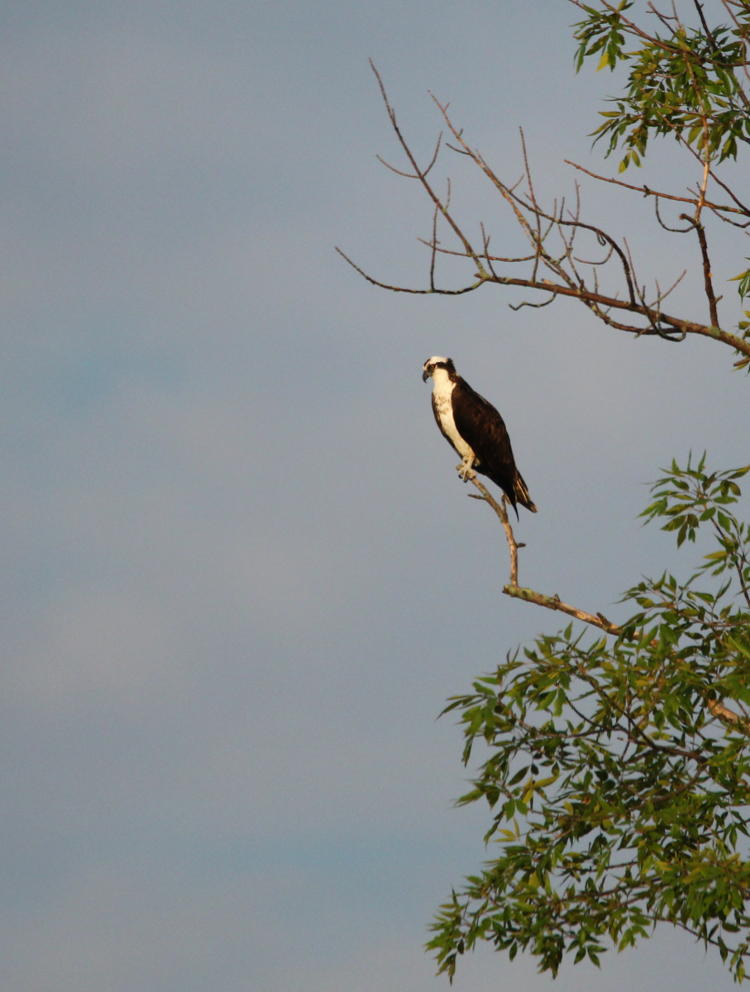
I was staying on the east side of the lake, on a cove, so the best views of the birds came at sunset as the sun was low and almost right behind me. I would have thought that the fishing done by osprey would take place long before sunset, as the higher sunlight was able to penetrate the water significantly, but they proved me wrong several times as I watched them diving while the sun was invisible over the horizon, so their eyes are far better than I originally gave them credit for. One, perhaps the same as seen above, cut across the cove and eventually alighted in a tree in the yard, during the twilight after sunset, and I was able to stalk up and get a few dim frames before it took off because of our presence.

The great blue herons were being even less cooperative and slightly perverse, since a pair of them flew over the base of the dock that I was standing on while my back was turned getting the last rays of the sun, and my hasty turn failed to get any worthwhile photo in the dim light, though a couple of minutes later I snagged a decently-fartsy pic that will appear in the second post. We were also visited by a pair of common terns (Sterna hirundo) that were actively fishing within the cove, but again, in crappy light at a great distance, and what I have is pathetic – my identification of the species only comes from having gotten much better details shots of some about 20 klicks north in Montezuma Wildlife Refuge a few days earlier.

My street cred as a nature photographer was taking a serious hit with these birds, let me tell you. Above, the tern is rising from the water just after catching a sizable (for the bird, anyway) fish, while below, I caught a curious composition as the tern shook itself in the air, a few moments after climbing from the water, to rid its feathers of excess water. I probably should have just been shooting video, since the low resolution is more acceptable there, but then again, I’ve already demonstrated how I am with tracking a moving subject. And we wouldn’t have these little water droplets hanging in the air like that ‘Cathy’ comic strip…

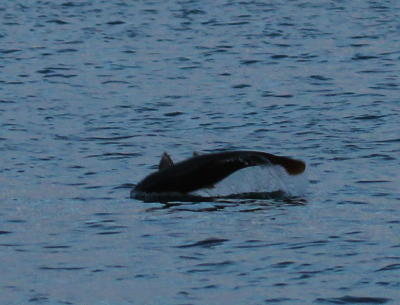 I feel a little better about the next morning, when the sunrise was largely obscured by clouds, as I snagged a fish jumping from the water. After the first two jumps, spaced well over a minute apart, I started ‘stalking’ the fish with the long lens since there seemed to be a weak pattern: between 50 and 200 seconds apart, getting a little further offshore each time, but within a ten-degree arc or so. I think I got this at the fourth jump, and I wasn’t so lucky with subsequent ones, but given the brief nature of the subject I’m cool with this, as tightly cropped as it is. Naturally, I want to get such images in better light within a useful and scenic setting someday.
I feel a little better about the next morning, when the sunrise was largely obscured by clouds, as I snagged a fish jumping from the water. After the first two jumps, spaced well over a minute apart, I started ‘stalking’ the fish with the long lens since there seemed to be a weak pattern: between 50 and 200 seconds apart, getting a little further offshore each time, but within a ten-degree arc or so. I think I got this at the fourth jump, and I wasn’t so lucky with subsequent ones, but given the brief nature of the subject I’m cool with this, as tightly cropped as it is. Naturally, I want to get such images in better light within a useful and scenic setting someday.
Meanwhile, on the same morning a flock of Canada geese (Branta canandensis) cruised low enough that I could frame them against the brighter water without losing them in the darkness of the trees.

Out investigating the property one morning, I spotted some movement on a nearby tree, and followed it up by eye as I crept closer by foot. Initially, the thin tail and the muted overcast light made me think that I might have actually found a northern flying squirrel, a species that I have yet to see, but eventually I determined that it was an American red squirrel (Tamiasciurus hudsonicus) instead, something that I have seen before, but not for the past three decades since I left NY.

American red squirrels are very small, just a little larger than a chipmunk and so about a third or less the size of the common grey squirrels visible everywhere, both of which (with poor tolerance) shared our yard when I was growing up. I witnessed a territorial dispute once, with a grey taking off in hot pursuit of a red across our yard, blindingly fast, until the red pulled an abrupt 90° turn in complete disregard of the laws of physics, causing the grey to overshoot by a solid two meters before it realized that it was no longer pursuing the intruder, but that was much too late to resume its chase. Personally I was impressed with a turn that should logically have given the squirrel an aneurysm…
The white-tailed deer (Odocoileus virginianus) were by far the most cooperative, as there were several families living on a large parcel of untouched land, so they were reasonably mellow; it’s a shame that there are only a few billion deer photos out there (well, there’s a few billion bald eagle photos as well, but I haven’t added those to my stock folders yet, so…)
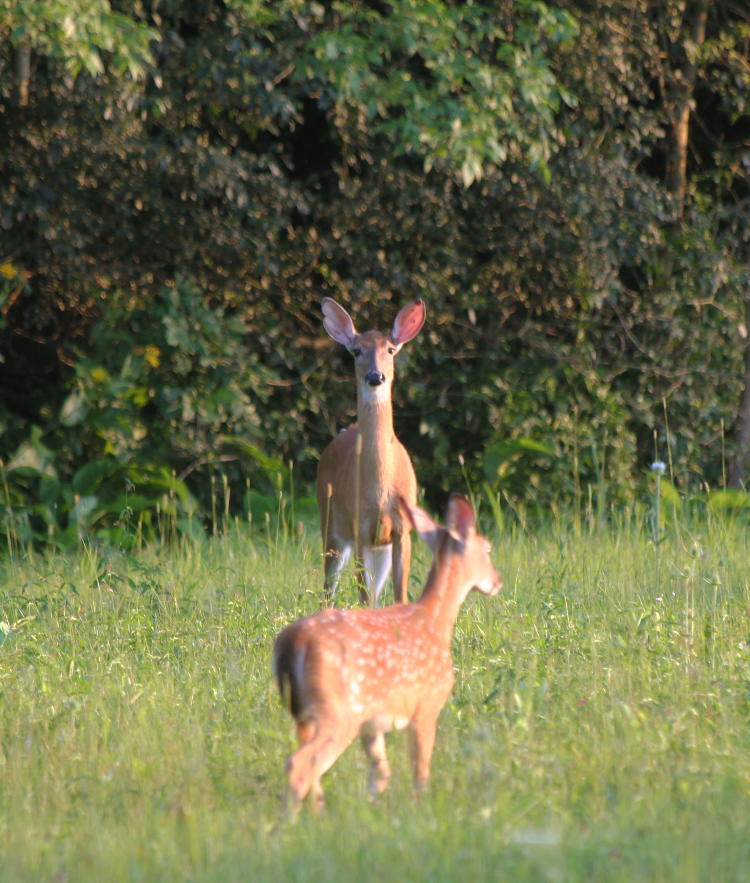
I saw one family – buck, doe, and twin fawns – a few different times, and my brother told me they were common around the property, but for this session they were nicely colored by the setting sun.
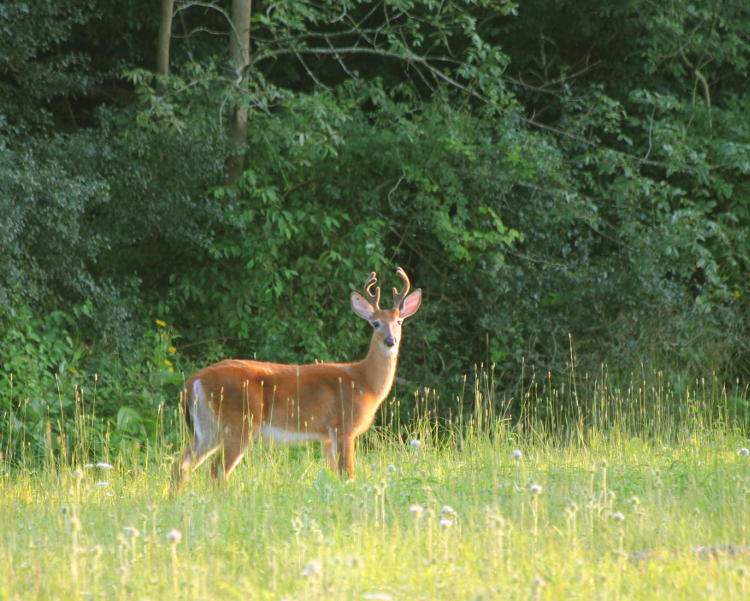
The buck distinctly showed the velvet of the developing antlers in anticipation of rutting season in the fall.

Eventually, they decided our approach in my brother’s car was a little too suspicious, and they fled – but not far, since we spotted them again within the hour and not a hundred meters away.
Earlier, I’d watched another doe and fawn crossing the lengthy driveway as I’d driven back in, and slowly approached while aiming the camera out the window, letting the car drift forward without benefit of steering or looking, hoping that it wasn’t heading towards the ditch. But it was necessary to try and get the obscuring bracken free from both of their faces for the shot.

This, by the way, is only an 85mm focal length – they were just a handful of meters off the driveway. Would have been nicer if the osprey or eagles had been so complacent…
And I close with a more typical offering from me, the first morning that I was there after it had rained at sunrise. Some of the bushes were liberally strewn with spiderwebs, to catch all of the mayflies and midges that the lake produces and the flowers and berries attract – at times you could actually hear the bushes hum from all of the activity. But here a long-jawed orb weaver (genus Tetragnatha) takes shelter alongside some unidentified berries, and I’m even doing it a disservice showing it at this resolution. because the eyes are quite distinct. Drop me a line and a few bucks and I’ll send you a print suitable for framing and displaying proudly on your living room walls.
